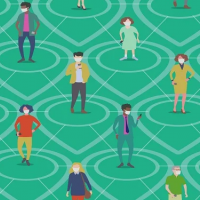
Are digital contact tracing technologies effective during infectious disease outbreaks?
Why is this question important?
The global COVID‐19 pandemic highlights the importance of accurate and timely contact tracing. Contact tracing tells people that they may have been near someone with ‐ or showing symptoms of ‐ an infectious disease, allowing them to self‐isolate and helping to stop the spread of infection. Traditionally, contact tracing begins with notification that someone has an infectious disease. They are asked to recall their contacts, going back two to three days before symptom onset. This is time‐consuming and may not always give a complete picture, so digital aids could help contact tracers.
Digital contact tracing uses technology to track and trace contacts. Individuals download an app onto their smartphones and record location and symptom information, or their devices might use location‐finding technology, like Bluetooth or GPS (global positioning system). If the user is infected, the technology identifies close contacts and/or secondary infections (people to whom they passed the disease), and informs people whom they have been near. The technology identifies where the infection was passed on and its duration (the context).
However, problems may occur where access to technology is limited, in low‐income settings or for elderly people, for example. Also, some people see it as an invasion of privacy and are suspicious of how their data will be used.
We wanted to know whether digital contact tracing, compared to manual contact tracing, is effective in reducing the spread of infection, as measured by secondary infections, identifying close contacts, tracing a complete set of contacts, and identifying the context of infection.
What did we do?
We searched medical databases for studies that assessed digital contact tracing. We preferred studies set during infectious disease outbreaks, which assessed real people in real time, but we included studies in any setting and of any design.
To answer our question quickly, we shortened some steps of the Cochrane review process, however, we are confident in our conclusions.
What we found
We found 12 relevant studies. Six assessed the effectiveness of digital contact tracing on specific groups (cohorts) of people: three during an outbreak (Ebola in Sierra Leone; tuberculosis in Botswana; and whooping cough (pertussis) in USA); and three replicated an outbreak in schools to assess systems for identifying close contacts of participants. The remaining six were modelling studies, which simulated digital contact tracing.
Main results
Digital contact tracing with self‐isolation probably reduces the number of secondary infections, but not as much as manual contact tracing with self‐isolation (2 modelling studies).
Digital contact tracing found more close contacts in two outbreaks than manual (2 studies in USA and Sierra Leone). Devices in non‐outbreak settings can identify more close contacts than self‐reported diaries or surveys.
An app may reduce the time to complete a set of close contacts (1 study). Digital systems were faster to use than paper systems for recording new contacts and monitoring known contacts, and possibly less prone to data loss.
Problems with system access (2 studies) included patchy network coverage, lack of data, technical problems and higher staff training needs. Contact tracers' personal expenses increased (1 study) due to travel and recharging phone batteries. Devices all appeared to protect diagnosed users from contacts, snoopers and authorities but one app's users were members of public health agencies. Studies recorded stolen hardware (second‐hand mobile phones); reported that paper forms were "often lost", and that digital data were password protected (2 studies) and encrypted (1 study).
We found no evidence on contextual information and acceptability.
What this means
It is unlikely that digital technologies would be the sole method of contact tracing during an outbreak; they would probably be used alongside manual methods. Unfortunately, the technology is largely unproven in real‐world outbreak settings and none of our included studies assessed digital plus manual contact tracing with digital contact tracing alone. Our included studies assessed different technologies and used different methods from each other, so we are uncertain about their evidence.
Governments that implement digital contact tracing should ensure that at‐risk populations are not disadvantaged and take privacy concerns into account.
This review is up to date to May 2020.

